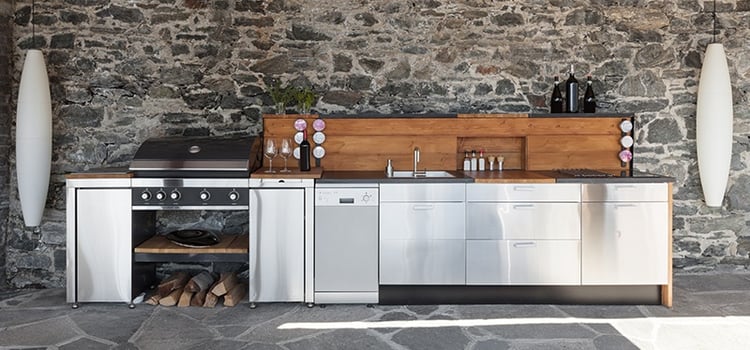
There is no better way to take advantage of everything Northwest Florida outdoor living areas can offer than enhancing them with the ultimate outdoor kitchen installation. Few places in the United States can compete with Florida’s sunny days and pleasant year-round temperatures.
By adding a luxurious outdoor kitchen to your backyard entertaining area, you’ll eliminate the inevitable chaos running back and forth to get things from your indoor kitchen causes. Cooking outdoors allows you to enjoy the beautiful weather as well as spend more time with your family and guests. Your energy bill will also put a smile on your face since the costs of maxing our your AC to compensate for your indoor cooking will be a thing of the past!
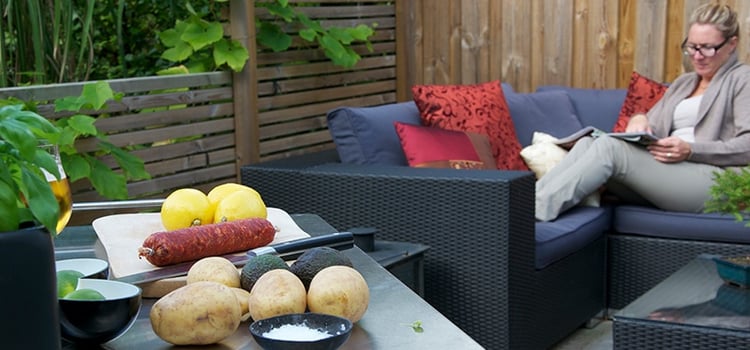
Save money, spend more time with loved ones, and enjoy the great outdoors - what’s not to love about creating the ultimate outdoor kitchen?
Before you get too eager putting together a wish list of everything you’d like to have in your dream outdoor kitchen, step back and read through this comprehensive guide. We put this guide together just for you, and it includes guidelines and regulations FEMA and Florida’s Department of Emergency Management established to ensure that Florida property owners comply with state and local building code requirements as they design and build the outdoor kitchen of their dreams. We also include key safety tips to help you safely enjoy your outdoor entertainment space.
Complying with Florida and FEMA Residential Building and Safety Codes
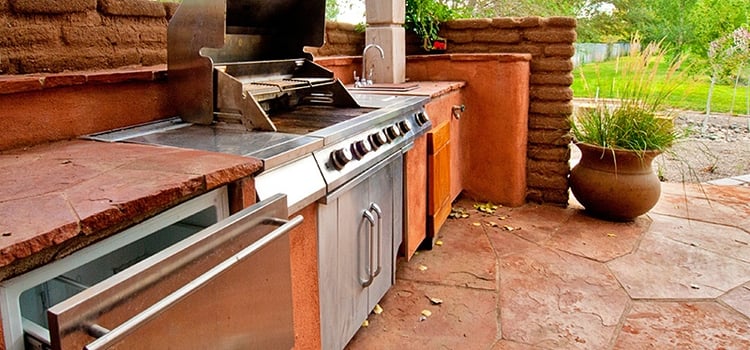
Because the GreenEarth service area lies along the Gulf Coast, we need to focus on mitigating flood and hurricane damage with our hardscape installation and outdoor kitchen installation. Here are two key considerations when planning your kitchen area:
Structural
The National Flood Insurance Program and the Florida Disaster section of the Florida Department of Emergency Management explain that all bars and counters that are not in an existing walled or covered area must be elevated to prevent water from rushing into cabinets, appliances, or storage areas. They must also be anchored so they can’t float away in fast-moving water.
Electrical
Since 1973, The National Electrical Code requires that outdoor kitchens use Ground Fault Circuit Interrupters (GFCI). Also, since 1987, electrical outlets installed near water sources must have a GFCI. For safety reasons, all outdoor kitchen electricity should flow to a separate GFCI panel. Installing master shut-off valves will allow you to turn off all the utilities that power your outdoor living and eating spaces, quickly and easily.
Next, we cover 7 key steps in planning and building your ultimate outdoor kitchen area.
Step 1 - Evaluating Your Grilling Station and Outdoor Dining Areas
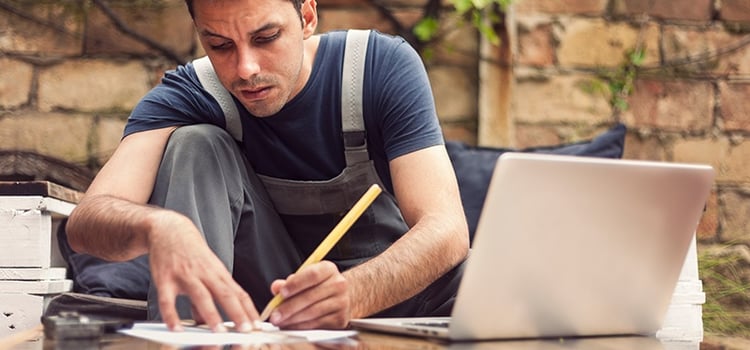
Take a good look at all corners of your outdoor living space. Evaluate your grilling station and outdoor dining arrangement. Figure out what you like about your current outdoor cooking area and what you don’t like. How big is the current space? Can you expand it without giving up the valuable area you use for something else?
Step 2 - Choosing the Perfect Location
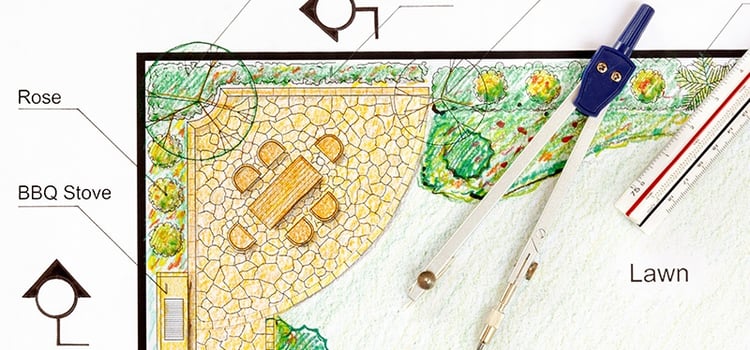
A deluxe outdoor kitchen can be as large or as lavish as your budget, and as large as your property will allow it to be. If you spend most of your time around a pool, then it would make sense to put your outdoor kitchen in a location where eating and pool activities can take place simultaneously.
If you need to be running into the house to get supplies all the time (we’re hoping your ultimate kitchen can fix this problem!), then it makes sense to choose a location that’s convenient to your indoor kitchen. You also must think about the convenience of connecting your dream outdoor kitchen, to your home’s other utilities and water supply.
Step 3 - Figuring Out What Utilities You Need and Where
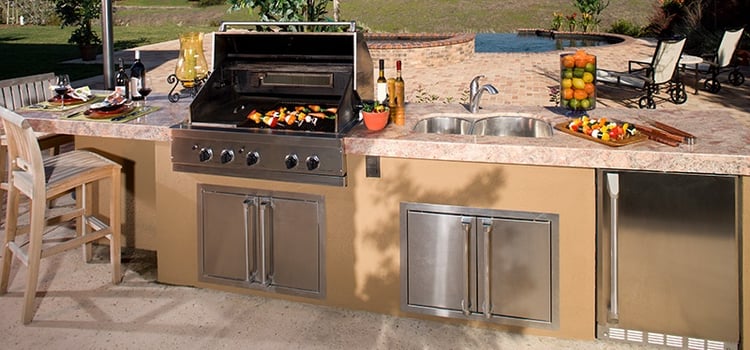
If you already have gas lines to your home for cooking, or for hot water to keep your pool warm, the cost of adding gas lines in your outdoor kitchen will be inexpensive.
Always think of ways to utilize the existing energy source already installed in your home to save on costs. For examples:
- Using gas to power your grill, cooktop, and outdoor oven real cost-saving advantage, especially if you prefer not to use wood or charcoal.
- If you intend to have a refrigerator for wine, beverages, and for perishable food, you must be able to connect appliances to water lines and electricity.
Before you contact your utility company to schedule an appointment for service installation, make a list of every large or small appliance, fun or useful gadget, entertainment component and other necessities that you must hook up with gas, electricity or water. Don’t forget to include the power that your outdoor lights and ceiling fans use. For example, the amount of gas your pool heater, grill, cooktop and other gas-powered appliances use will determine the size of the supply pipe you’ll need. The same can be true for water and electricity as well.
Step 4 - Designing a Functional Outdoor Kitchen Layout
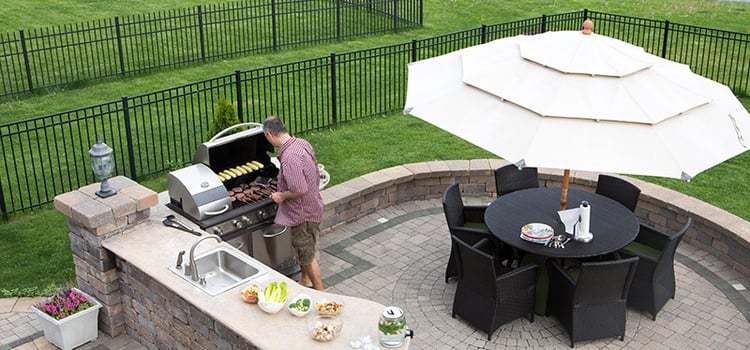
A functional layout allows you to create zones for the different activities you’ll be doing in your outdoor kitchen. By grouping similar activities together, you’ll not only have a more efficient kitchen; your layout will make it possible to install utilities with optimal efficiency.
When designating activity zones, take measurements and even try sketching it out or using a software program to layout the space on your computer. Make sure you include plenty of counter space for food prep, serving, and a safety barrier that lessens the likelihood anyone will get burned by getting too close to a hot surface. Here we’ve included a simple list of appliances, fixtures, and activities that correspond to each zone.
Hot Zones - include everything that generate heat
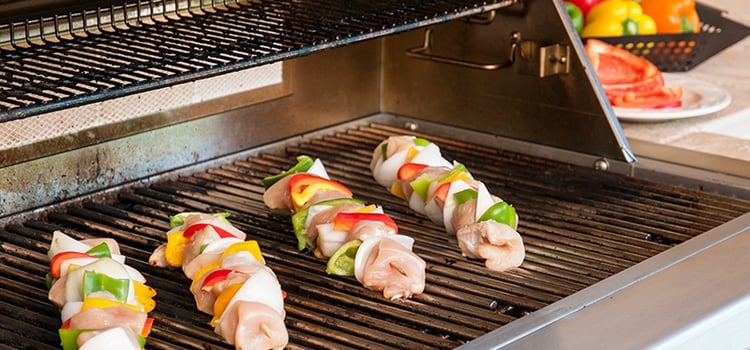
- Grills
- Cooktops
- Pizza ovens (either wood-fired or gas-powered)
- Fireplaces and Firepits
- Wood ovens
- Warming drawers or ovens
Don’t forget to include utensils and accessories like tongs, spatulas, and potholders you use when grilling, using the cooktop, or the pizza oven.
Cold Zones – includes everything to keep food and beverages cool, cold, or frozen
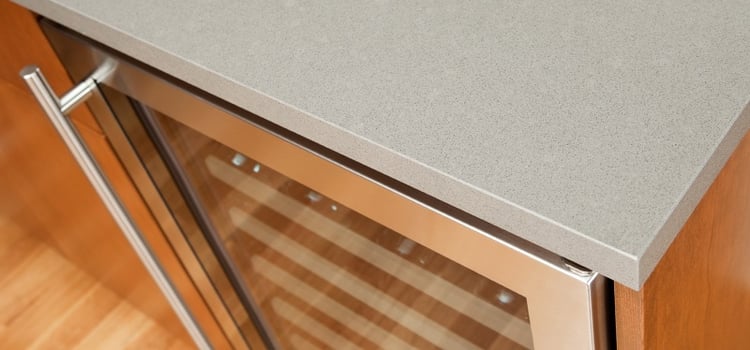
- Refrigerator(s)
- Wine cooler
- Ice/filtered water
- Freezer
- Beverage refrigerator
- Beer tap
Wet Zones – includes all water sources for your kitchen
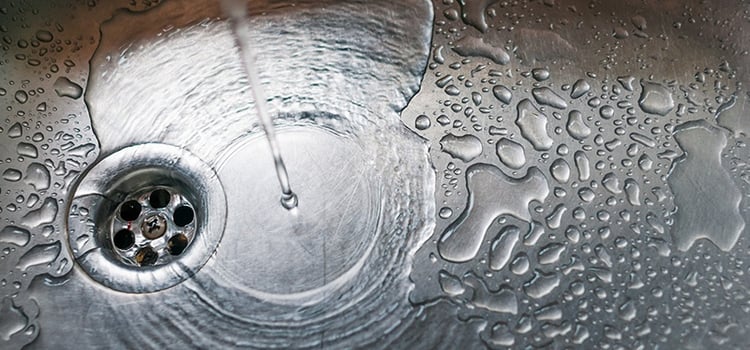
- Sink
- Wet bar
- Dishwasher
Dry Zone – includes all prep and serving areas
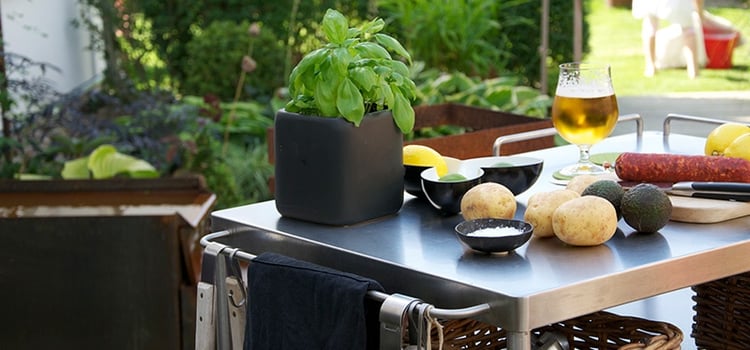
- General food prep areas
- Spice, dry rub and non-perishable food storage
- Cooking utensils
- Dish and glass storage
Step 6 - Choosing Appliances and Cooking Equipment
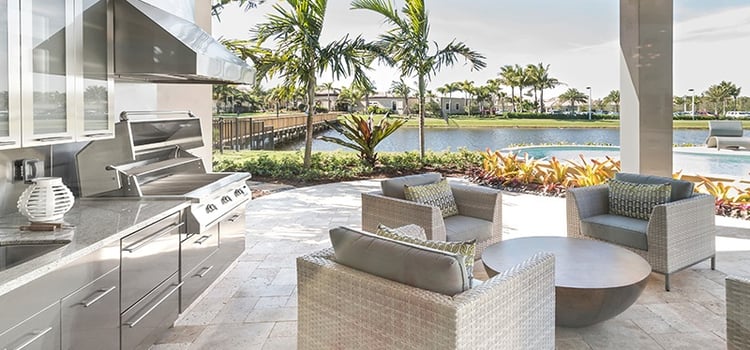
Grills
Homeowners can choose between gas or charcoal or wood powered grills. Charcoal or wood give food the authentic taste that real barbecue lovers want. Charcoal or wood engage people as they gather around the grill, taking in the smells and enjoying the companionship.
Gas grills offer convenience and are much easier to maintain and clean. There are also hybrid/combo grills that offer the convenience of gas and the experience of an open fire that charcoal and wood provide.
Smokers
For traditional old-fashioned barbecue enthusiasts, a smoker is the way to go. A smoker is an outstanding addition to a Northwest Florida outdoor kitchen because homeowners can smoke the fish they catch. Smokers should be used in conjuction with other cooking surfaces so make sure to consider a cooktop or grill as well.
Refrigerators
Refrigeration choices include wine coolers, beer kegs, beverage coolers, ice makers, refrigerator drawers, and freezer drawers.
Cooktops
Sophisticated outdoor cooktops are comparable to any top-of-the-line models that are so popular in 21st-century indoor kitchens. A high-end outdoor cooktop will let do all the things you can do on your indoor kitchen cooktop. Sometimes these can be even more versatile since smoke and fire is far less of a hazard outdoors as it is inside your home.
Other Appliances to Consider
If you do a lot of outdoor entertaining, you might want to consider:
- An ice crusher or high-powered blender for smoothies, cocktails, or fun tropical juice drinks
- A built-in beer tap to give you access to draft beer, so you don’t have to fill a beverage cooler with cans or bottles of beer
- A wood or gas-powered pizza oven if you are a homemade pizza or bread enthusiast
Step 7 – Choosing the Right Cabinets and Countertops
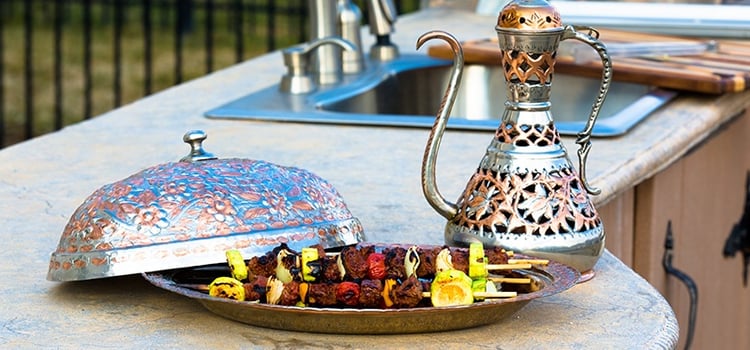
Most outdoor kitchen cabinetry is made of metal because it is easy to maintain and most metal will tolerate the ravages of nature. Given our close proximity to the Gulf of Mexico, any material you choose for cabinets or counters must resist corrosion from salt spray. Consider using concrete, stainless steel or other solid, non-porous, low-maintenance materials that are easy to clean and resistant to stains for your countertops.
Quick Safety Tips for a Safer Outdoor Kitchen Area
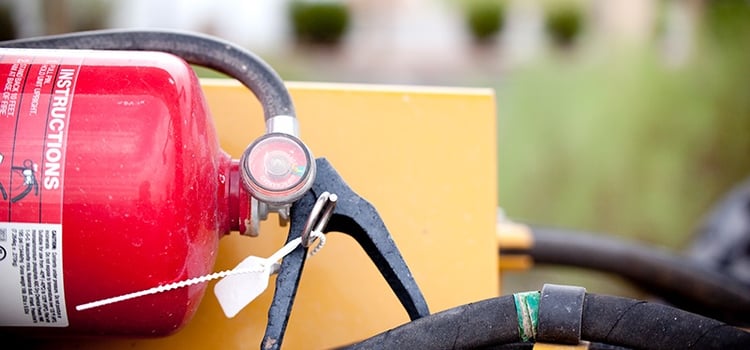
The get the most out of your outdoor living space and kitchen, make sure your design, hardscaping and kitchen installation include features that protect people and keep your property safe. Here are a few quick safety tips to keep in mind when planning or updating your outdoor kitchen.
- Add a minimum of 9 inches of extra countertop space on all surrounding sides around hot cooking areas of the heat-generating appliance.
- Make sure that your grill and other open-flame cooking appliances are far enough away from combustible surfaces to prevent a fire.
- Make sure that your design includes space for fire extinguishers.
- Have your utility installers include a clearly visible gas or electric shut-off valve close by to quickly power down the kitchen in case of emergency.
- Make sure that all flooring material around the pool, outside kitchen and living areas offers enough traction to protect people from slipping and falling.
- Eliminate potential injury from sharp countertop corners by rounding the edges to make them smooth.
- When licensed electricians install outlets and a separate Ground Fault Circuit Interrupter panel, ask them to include a master shut-off switch that turns off all electricity. That switch should be clearly visible and easy to access.
Let GreenEarth Help You Create the Outdoor Kitchen and Outdoor Living Space of Your Dreams
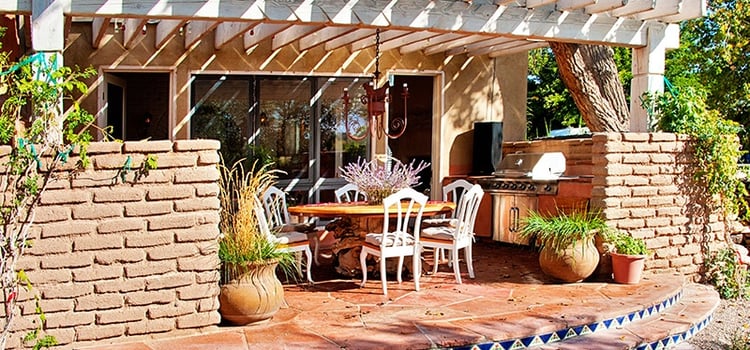
We share your passion for spending time outside. We know how important it is for all Northwest Florida property owners to have a functional (if not luxurious) outdoor kitchen and living space. When planning the outdoor kitchen of your dreams, you can benefit from our expert advance and design architects. Count on the GreenEarth team to help you create the best outdoor living, entertaining and kitchen space possible for a reasonable price.
Whether you call us about your primary residence or a vacation home, we make sure you get the value and quality you want from an outdoor living space and outdoor kitchen installation project.
If you’d like a consultation or want to know what we can do to help you, give us a call at our Panama City Beach office at (850) 236-1959, or call our Santa Rosa Beach office at (850) 267-0010 to set up an appointment. You can also fill out the online form on our website to schedule a consultation.
.png?width=7889&height=5988&name=GE%20LOGO%20clear%20(1).png)
